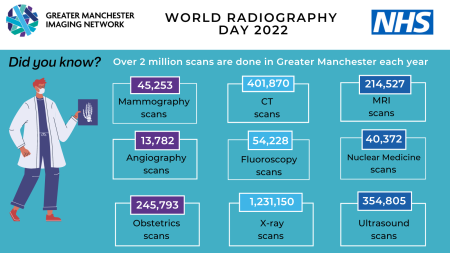In this blog post, Elaine Quick, 
World Radiography Day takes place on 8th November every year to celebrate the discovery of x-radiation by Wilhelm Roentgen in 1895. Wilhelm Roentgen was a German engineer and physicist, who’s discovery of x-ray changed the way health professionals determine a range of issues for patients by producing high quality images of inside the body.
The aim of the day is to raise awareness of x-ray imaging and therapy which plays a vital role in patient diagnosis and treatment.
Radiography is often the first step to developing patient care and involves many more imaging methods than the original Roentgen x-ray discovery. It now includes:
- Angiography – this type of x-ray is used to check blood vessels. Blood vessels do not show clearly on a normal X-ray, so a special dye needs to be injected first which highlights blood vessels. This allows health professionals to see issues clearly.
- Computerized tomography (CT) – this scan combines a series of X-ray images taken from different angles around the body and provides more detailed information.
- Magnetic resonance imaging (MRI) – this scan uses strong magnetic fields and radio waves to produce detailed images of the inside of the body. An MRI scanner is a large tube that contains powerful magnets and patients lie inside the tube during the scan. An MRI scan can be used to examine any part of the body.
- Fluoroscopy – this type of scan takes a real-time video of the movements inside a part of the body by passing x-rays through the body over a period of time.
- Mammography – this scan is used to detect breast cancer early in women, when it is treatable and uses low-dose x-rays.
- Ultrasound - This is also known as a sonogram. This type of scan uses high-frequency sound waves to create an image of part of the inside of the body. It is used to monitor an unborn baby, diagnose a condition, or guide a surgeon during certain procedures.
World Radiography Day also celebrates Radiography as a career in today’s modern health care. Radiographers work through a range of hospital departments and specialties performing examinations for patients. These areas include outpatients, hospital wards, A&E departments and operating theatres.
Being a radiographer provides many opportunities to gain new skills, advance practice and provide leadership through to management opportunities. A radiography career contains a mix of scientific, technical, and social skills to provide support and reassurance to patients, and ensures patients receive the lowest dose of radiation to gain the best images.
During the Covid-19 pandemic, radiographers played a vital role, working on the front-line by performing chest x-rays and CT scans on the critically ill to help diagnose the virus and treatment needed.
Approximately 44 million imaging tests are performed each year in the UK, with 2 million being performed in Greater Manchester.
